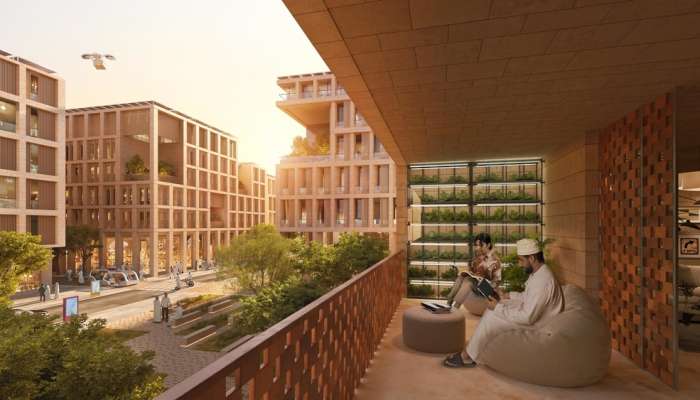
Muscat: The Sultanate of Oman is striving to develop smart cities that align with contemporary demands while fostering a connection between the past and present, embodying national identity and its imperatives as part of urban transformation.
The vision for the construction sector emphasises enhancing the harmony between heritage and modernity through innovative and distinctive approaches. This is clearly reflected in the integrated efforts to promote urban sustainability and human-centric development. Smart cities are being shaped by strategies that redefine the relationship between people and space, improve infrastructure, enhance quality of life, and accelerate economic growth.
National identity and its requirements are evident in projects aligned with "Oman Vision 2040." Sultan Haitham City stands as a prime example of smart cities, striking a balance between modernity and cultural distinctiveness while serving as a model for future urban development and a promising investment destination.
In this context, Hassan bin Ali Al Shukri, an architect at the Executive Office for Smart City Projects in the Ministry of Housing and Urban Planning, states: "Smart cities in Oman are not merely digital infrastructures but tools for revitalizing identity and improving quality of life. They draw inspiration from traditional Omani architecture and its deep understanding of the environment and societal behavior. Oman adheres to timeless architectural principles that seamlessly integrate with modern technologies, such as smart sensing systems, lighting control, and climate simulation."
Al Shukri added that traditional Omani architecture offers an advanced functional model, utilizing local building materials that reduce emissions and provide natural thermal insulation. Windows and mashrabiyas (lattice screens) intelligently regulate ventilation and lighting, while compact urban planning incorporates shaded pathways to encourage walking and reduce street heat. He explained that Oman’s smart cities take cues from history to shape a future rooted in people’s environment and culture, transforming heritage concepts into sustainable practical solutions.
Omani heritage—including systems like aflaj (traditional irrigation), earthen buildings, and narrow alleyways—provides a scalable design framework for smart cities. These elements become effective tools for reducing energy consumption, improving air quality, guiding pedestrian movement, and enhancing visual and urban harmony.
He emphasized that the foundations of Omani architecture—environmental adaptation, sustainable construction, terrain harmony, and intelligent resource management—must endure in smart cities. Oman can translate this approach by blending tradition with innovation, prioritizing community over technology, and promoting smart tourism linked to identity.
On his turn, Dr. Haitham Najim Al Abri, an architect and researcher specializing in Omani architecture and urbanism, noted that Oman possesses a unique distinctiveness in building arts and urban planning, reflecting the ingenuity of Omanis in harmonizing with nature and respecting resources. The wisdom and skills of ancestors have laid a solid foundation passed down through generations. He explained that Omanis have long understood how to build cities adaptable to diverse terrains—from mountains to coasts, deserts to oases—while preserving identity and sustainability.
Al Abri stated that smart cities are not mere replicas of global models but an extension of ancestral ingenuity, where technology enriches rather than erases identity. The new generation of Omani engineers are called to be guardians of this legacy, innovating in ways that prove Oman knows how to build its future without forgetting its past. The Omani smart city is not one that emerges from scratch but a renewed city where historical contexts thrive.
Amid the global race toward digital transformation, Al Abri pointed out local challenges in preserving architectural and cultural identity within smart cities. However, these challenges can become opportunities through a balanced approach. Key challenges include the standardized import of global models, weak digital documentation of architectural heritage, conflicts between technology and social values, a shortage of local professionals skilled in both heritage and smart city technologies, and economic costs.
To address these, he proposed solutions such as localizing innovation, comprehensive digital documentation of Omani architecture, enacting legislation mandating identity integration in design, hybrid education combining heritage and technology, and smart partnerships. Oman, he noted, possesses the potential to reconcile authenticity and innovation.
Meanwhile, Abdulaziz Mohammed Al Balushi, a property owner in Sultan Haitham City, highlights how heritage values are integrated into the technical infrastructure of smart cities, blending modern technology with authentic Omani principles. There is a clear respect for privacy in neighborhood and home designs, ensuring family spaces remain protected, while the social fabric is maintained through mosques, communal gathering spaces (majlis), and parks that encourage social interaction.
He adds that the visual and design character of Omani smart cities creates a living experience rooted in authenticity yet open to innovation. The visual language emphasizes Omani identity through architecture inspired by local history, such as traditional arches and engravings, while incorporating modern design elements like smart lighting, interconnected green spaces, and smart pedestrian and cycling paths. This fusion offers residents a living experience where they feel connected to Omani heritage while benefiting from modern conveniences.